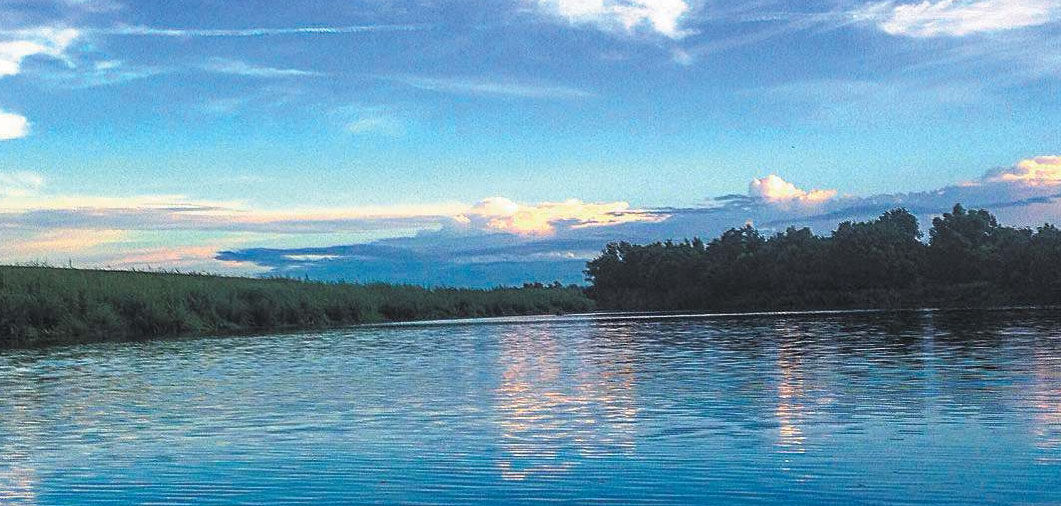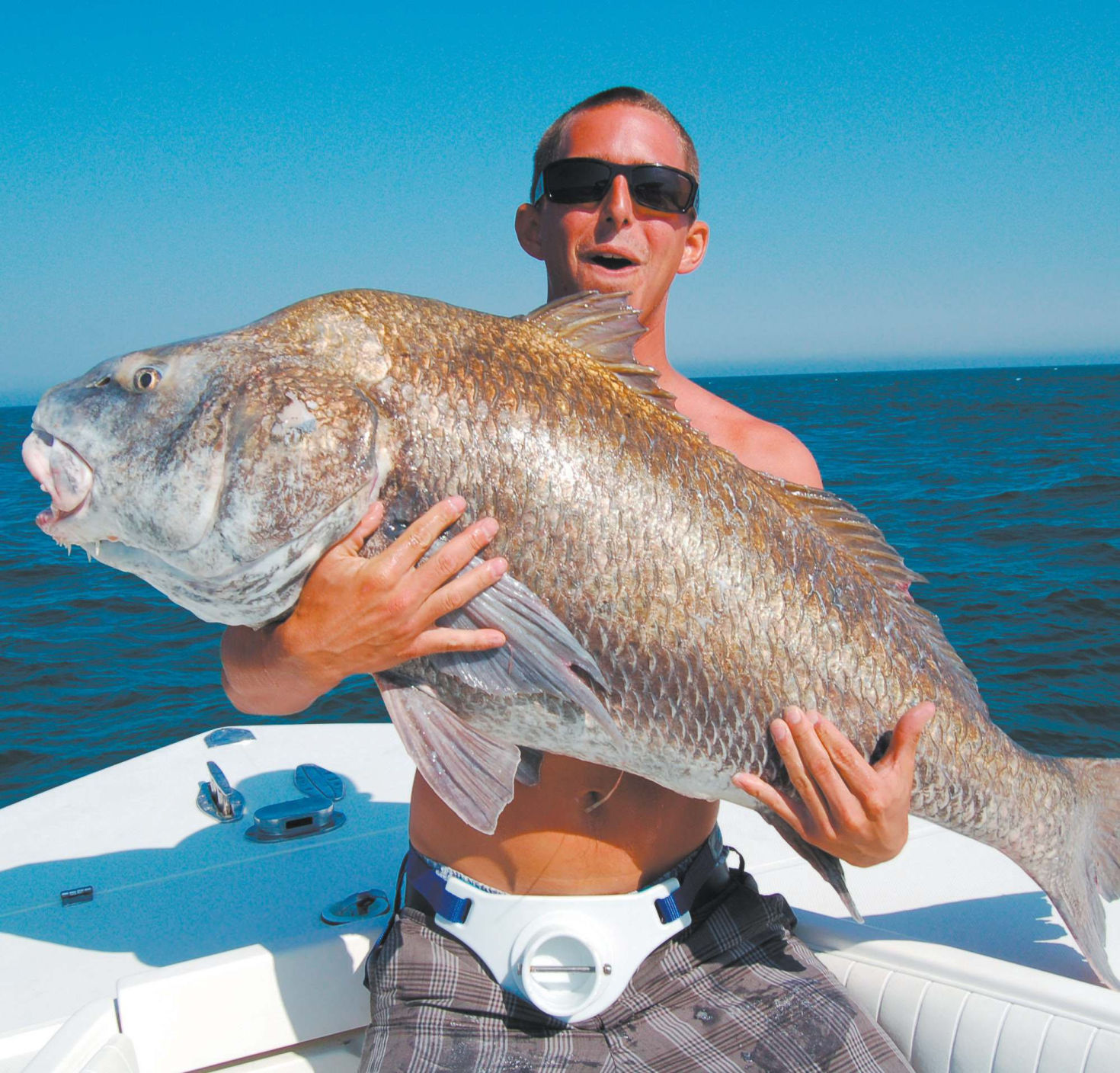
It’s 5K Time! Peltier Park race gives proceeds to Brain Aneurysm Foundation
August 26, 2015
OUTDOOR MEMORIES
August 29, 2015Not everybody can afford to buy a big boat or hire a charter captain for an offshore adventure, but anyone can experience tackle-busting action from big fish all along the Louisiana coast.
Often ignored or even distained by many Cajun sportsmen, black drum frequently venture into water only a few feet deep or plunge to more than 100 feet deep and may appear anywhere along the coast. Not many people intentionally fish for black drum in south Louisiana.
Anglers most often catch them by accident while chasing redfish, speckled trout and flounder, but the big, barbeled beasts can provide outstanding sport for anglers on a budget in almost any salty bay or bayou in the state.
“Sister Lake and tributaries off Grand Caillou Bayou hold good fish,” recommended Tommy Pellegrin of Custom Charters (985-851-3304, www.Customchartersllc.com) who normally fishes out of Cocodrie. “Oyster Bayou south of Morgan City near Four League Bay is famous for giant redfish and big black drum. The East Timbalier Rocks are a good place to fish for big drum. Lake Mechant and Lost Lake are very good around Dularge. Another good spot is Coon Point, the westernmost point of Last Island in Caillou Bay.”
Anglers can catch big drum in anything from a pirogue to a blue-water cruiser, but even sportsmen without boats can land really big fish with very little financial investment. Many people simply pull off the road at a likely looking spot and start fishing. Anglers frequently see monster drum around marinas. Docks and landings with fish cleaning stations make excellent places to look for big drum. When anglers clean their catch at these stations, they toss heads, backbones and entrails into the water. This free protein attracts crabs and small fish. Drum gather to eat the crabs. Anglers cleaning fish often spot giant drum almost under their feet.
“Sometimes in a marina, we’ll look down and see a really huge drum moving along the bottom looking for something to eat,” remarked Mike Weaver, an avid saltwater fisherman. “They can
be prehistoric looking when they get really big. It’s not unusual to catch drum weighing more than 40 or even 50 pounds. They really fight hard. Even a small drum is an excellent fighting fish. It’s a great fish to target when fishing with kids. They have a blast fighting a big drum.”
Black drum can put up a powerful fight. Related to redfish, the largest member of the drum family can weigh more than 100 pounds. Dylan Gonzales landed the Louisiana state record black drum, a 79.50-pounder, while fishing Oak Bayou in May 2007.
A black drum eats similar forage to its spot-tailed cousins, but prefer dead things more than live ones. Anglers sometimes catch drum on jigs tipped with soft-plastic shrimp tails or gold spoons, spinnerbaits and other lures while casting for redfish or trout. Drum even occasionally hit crab-or shrimp-pattern flies and streamers, but typically want meat. Like a big freshwater catfish, black drum scour the bottom looking for any morsels they can suck up such as clams and shrimp. Most people use live or fresh shrimp for bait, but drum also slurp squid, small live baitfish, such as cocahoe minnows or pogies, fish chunks or strips and other baits. However, the big barbeled fish typically prefer crustaceans to fish or most other baits.
“Black drum have several great big, fleshy, barbels hanging on the underside of their lower jaw and are predominantly bottom-feeders with no great preference for any particular foodstuff,” explained Dr. Bob Shipp, (bobshipp.com) a marine biologist and author of Dr. Bob Shipp’s Guide to Fishes of the Gulf of Mexico. “Although they graze on bottom, shelled animals are a main feeding strategy. Drum are especially proficient at digesting thick-shelled animals like clams and crabs by using a set of heavy, crushing teeth that are borne on the bones that support the gills.”
Although anglers catch many drum with shrimp and other baits, nothing works better than a crab. For really big drum, anglers can use a whole fresh crab. Keep the top shell attached, but crack it to let juices ooze into the water. Drum might also hit a small live blue crab hooked through the back near the rounded swimmer fins.
Half a blue crab cracked open and reeking savory juices often proves too tempting for any drum. When fishing with a crab half, first break off the claws and toss them into the water for chum. Then, remove the top shell and break the remaining body in half. With the top shell removed, it should break easily into two nearly equal pieces. Run a hook through the meaty part so that the point exits out a leg hole.
In shallow marsh ponds, anglers can dangle a crab half under a popping cork, but most people fish a crab chunk on the bottom. Fishing for a big drum regularly requires patience. Fish either a half or whole crab on the bottom and let it sit for as long as necessary. Smaller fish like croakers or hardhead catfish may pick at the meat, but anglers can’t mistake when a big drum gulps a bait. Many anglers put their rods in holders and set their reels to click when something strikes and runs off with the bait. When a big drum takes a bait, don’t set the hook immediately. Let it ingest the bait for a few seconds. When fishing with circle hooks, simply begin to reel in after feeling the fish on the line.
“It’s hard to beat a crack crab when fishing for big drum, except when using a soft-shelled crab,” Pellegrin quipped. “I use a 7/0 circle hook on Carolina rig with the slip sinker above the swivel and leader. When people fish cracked crabs, big fish normally swallow the bait and the hook. A circle hook catches a fish in the corner of its mouth, so it’s very easy to release it unhurt. We keep some small drum to eat. I think puppy drum, those in the 16-to 24-inch range, are better eating than redfish.”
While redfish often cruise shallow marshy shorelines, big drum frequently drop into deep holes in bayous and passes that flow into the Gulf of Mexico or adjacent bays. Cracked crabs on a Carolina rig work great for fishing such holes. A big bend in a bayou makes a great place to look for drum. Tidal currents often scour deep holes in such places. Drum wait in these holes for bait to wash to them.
“At the edges of the passes are good places to fish,” Pellegrin advised. “Little Pass is one of the best places to fish in the fall. Other good ones include Whiskey Pass, Wine Island Pass and Caillou Boca behind Whiskey Island. A trough runs through there. It has some shell beds, cuts and deep water. The deeper areas of Oyster Bayou are the best places for big reds and drum. At the north end of Oyster Bayou, some big shell reefs and mudflats hold good fish. Grand Caillou Bayou is fairly deep.”
While most Louisiana anglers catch drum by accident, the large fish can provide outstanding sport. After investing a few dollars for bait, or better, a little effort catching bait, anglers can enjoy big-game action almost anywhere along the coast without riding the waves 50 miles into the Gulf of Mexico – or paying the cost!.
‘Sometimes in a marina, we’ll look down and see a really huge drum moving along the bottom looking for something to eat.’
Mike Weaver
Saltwater fisherman
Huge black drum like the one pictured can be caught with just a small expense to the angler. The prized fish can be had just off the coast, and anglers can snag them without a boat.
This massive black drum was the prized catch of this angler during a summer trip. Cajun Sportsman expert John Felsher said that these fish can be caught in abundance throughout the summer. Felsher said they can also be caught almost anywhere in salt water.









